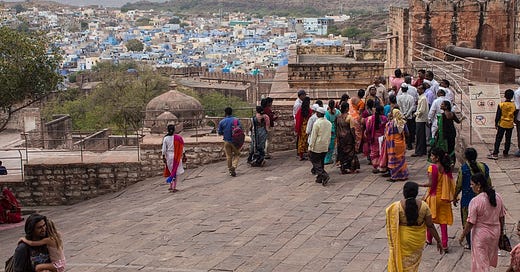Here's to a brighter 2021
Straight from the experts, these are the big issues to watch next year
Welcome back to Lights On, a newsletter that brings you the key stories and exclusive intel on energy and climate change in South Asia.
This is the last letter of 2020, a year of disasters - from super cyclones and trade wars to a pandemic that cast doubt on what we took for granted about our public health systems, economies and society. But although it left us exhausted, this year has been punctuated with teachable moments, and the feeling that every crisis sooner or later fades to a clean slate. The energy and climate change space was no exception to this shakeup. Off the back of the coronavirus challenge, Indians are rethinking a future clean transition, demanding wellbeing over political posturing, international cooperation over conflict and an end to the systemic faults exposed by the pandemic.
Here, six experts who contributed to this year’s Lights On coverage share their views on the issues that will matter most in 2021.
See you next year!
What’s next for China-India relations
Aditya Valiathan-Pillai, who works on climate policy with the Center for Policy Research
Keep an eye on how India and China structure industrial policy across a range of technologies such as solar cells, electric vehicles and batteries. The next few years will determine how a very competitive multi-decadal game will play out. For India, playing capacity catch up will mean tweaks to production incentives to keep investors happy, but the core problem is gloomy demand in the electricity sector and the economy at large. A crucial sub-theme is how they go about R&D with the race for end-of-decade technologies underway. Despite current fiscal circumstances, India will have to find the spare change to put itself in the running.
Take a look at this year’s China coverage
What’s next for solar energy
Subrahmanyam Pulipaka, CEO of the National Solar Energy Federation of India
While Covid-19 eclipsed the pace of installations in 2020, I believe 2021 is going to be a better year in terms of installed capacity. We expect a minimum of 10 GW installations to come up next year. In a higher scenario as much as 14 GW of solar capacity addition is possible which, if it happens, will make 2021 the best year so far for the Indian Solar industry.
With the target of 100 GW just 24 months away and 60-odd GW projects to be commissioned in 2 years, every month of 2021 is going to be crucial. 2021 might also witness new companies foraying into manufacturing for solar, intensified proliferation of solar pumps for agriculture and evolution of hybrid, round-the-clock bids that combine conventional power generation sources with solar/wind along with storage. All-in-all it appears to be a very positive outlook for Indian solar in 2021.
Take a look at this year’s solar energy coverage
What’s next for electric mobility
Abhishek Saxena, EV and climate change specialist with NITI Aayog
Mobility across the world, and in India, is at a crossroads in the post-Covid world. Countries have to make a choice whether to go for sustainable, clean & zero emissions mobility or stay with archaic fossil fuel based solutions.
India, with its strong commitment to the Paris pact, would undoubtedly be a leader in the global electric mobility revolution. The idea of moving towards a clean mobility solution resonates well with the core ethos of India, to look at the world as one. The climate crisis is the biggest catastrophe waiting to happen for mankind.
India's mobility in 2021 would make a strong leap towards electric on the backbone of public transport. That is the best, and only, way forward for India.
Take a look at this year’s EV coverage
What’s next for power reforms and coal transition
Ashwini Swain, energy researcher at the Centre for Policy Research
India’s energy policy had significant churns in 2020, resulting in strong signals in favour of clean energy as well as a protective impulse for coal. I think the priority for 2021 should be to develop a coherent and comprehensive energy strategy. Picking ‘champions’ and ambitious targets are important. But governments at the Centre and states need to prioritise institutional configurations, address distributive concerns and engage with political opportunities and costs (along with techno-economic opportunities/costs) of reforms.
On coal specifically, in 2020 we saw an embryonic domestic demand for coal phaseout in India, particularly calls for accelerated retirement of old coal power plants and no new coal capacity. It would be interesting to see how that shapes up next year.
Take a look at this year’s coal coverage
What’s next for climate diplomacy
Karthik Ganesan, energy researcher with the Council on Energy, Environment and Water
In 2021, India’s main focus must be to address the local environment – air and water pollution, and protect its rich biodiversity. While the world is looking to India to ratchet up climate ambition, India is punching well above its weight and has an unwavering commitment to transition away from fossil fuels. Increasing our commitments can wait.
Take a look at this year’s climate diplomacy coverage
What’s next in the fight against air pollution
Sunil Dahiya, analyst at the Centre for Research on Energy and Clean Air
Learning from 2020 that reduction in emission load can result in clean air and blue skies, 2021 is going to be a year when cities in India move towards putting out information on pollution emission load estimations – something that is already in process. This exercise will help geographies in systematically targeting the pollution sectors while putting the emission caps and emission reduction targets in alignment with absolute pollution reduction targets.
Take a look at this year’s air pollution coverage
If you enjoy Lights On, you can subscribe here for free or become a member:




